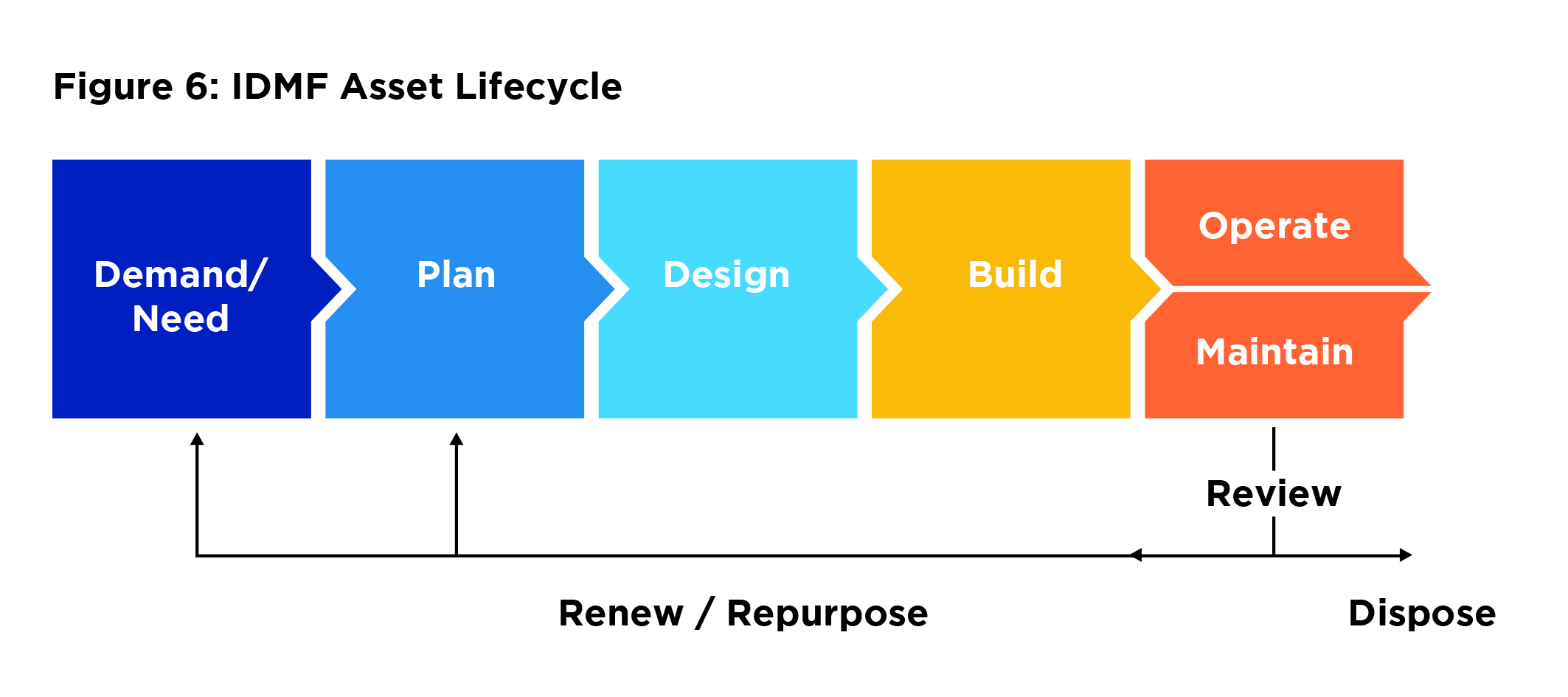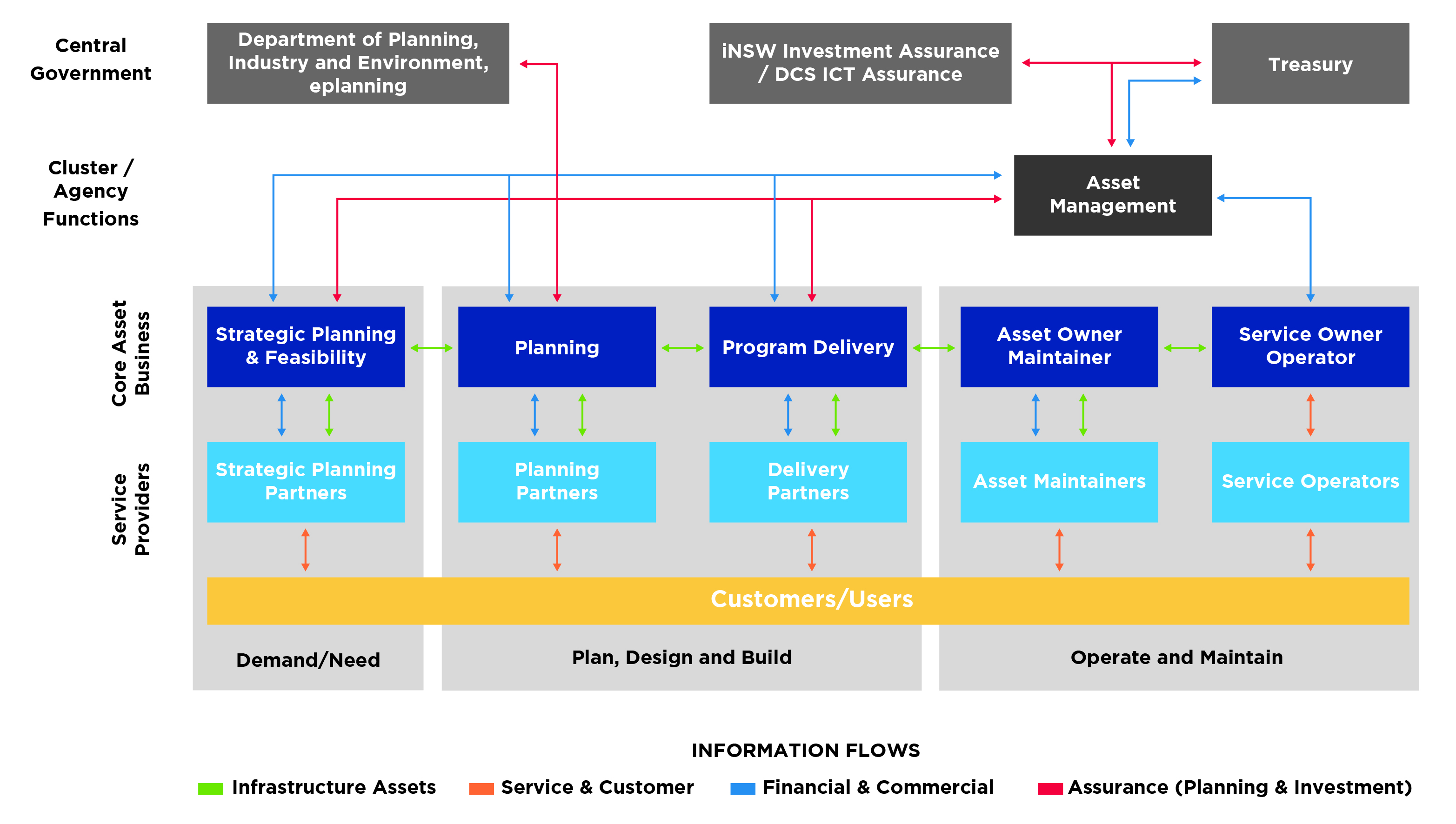Asset management can be defined as the coordinated activity of an organisation to realise value from assets, present and future. Value can represent financial return and/or be measured by the contribution the assets make to service delivery through both function and performance.
The NSW Asset Management Policy sets out core asset management practices for NSW Government agencies to adopt and also mandates a whole-of-government and whole-of-asset-lifecycle approach.
A core element of effective asset management is having decision-making that is evidence-based and data-driven. A pre-requisite for this to happen is to collect sufficient data, and ensure accuracy of the data and documentation in order to:
- Support development of assets
- Support efficient operation and maintenance of assets
- Support effective communication with all stakeholders, from whole-of- government decision makers to the public as users of the infrastructure
- Meet legal and statutory requirements
- Ensure the smooth transition of the asset from one stage in its lifecycle to the next
- Monitor Asset Financial Management
- Monitor Asset Condition/Performance
- Monitor the Asset Audit and Assurance.
As defined by the State Infrastructure Strategy’s six strategic directions, the NSW Government is constantly striving to improve the decisions made around infrastructure, whether it involves:
- Strategic assessments
- Planning and development
- Project approvals
- Maintenance and operation of existing and new infrastructure assets, or
- Replacement or disposal of assets outside of their useful life.
The IDMF plays a key role in supporting decision making by ensuring that agencies can identify data requirements, and that data on infrastructure is collected and used to better support data driven decision making. Several frameworks exist to support agencies to make better decisions during the different development and delivery phases, including:
- Infrastructure Investor Assurance Framework (IIAF)
- ICT Assurance Framework
- Infrastructure Australia’s Assessment Framework (for Federally funded programs).
The generic infrastructure asset lifecycle shown below illustrates the typical lifecycle stages as defined in AS ISO 55000:2014 Asset management — Overview, principles and terminology and by the Institute of Asset Management (IAM), and is used in the IDMF to support concepts and requirements defined within the framework.

The asset lifecycle consists of the following stages:
- Demand / Need – This initial stage establishes and verifies operational, service and associated infrastructure asset requirements. For existing infrastructure, it is based on the performance of the existing assets and their potential to meet service delivery needs, while for new assets it is determined based on the requirements for new infrastructure to meet service delivery requirements.
- Plan – Based on the requirements developed in the Demand / Need stage the project will select the best concept (options) for Design and Build stages. Following the necessary approvals, the proposed solution is progressed through the specification and procurement processes.
- Design – Design is focused on enhancing the design of the preferred option, ensuring that it is fit-for-purpose and able to meet the customer’s requirements.
- Build – Following approval of the final design the infrastructure assets are constructed in accordance with the approved design and handed over to the Operator / Maintainer.
- Operate and Maintain – During the Operate and Maintain stage the infrastructure assets are placed into service and maintained with the aim to optimise the condition of the assets whilst supporting the functional performance of the assets to deliver the required services.
- Renew / Repurpose – When an asset reaches the end of its useful life or is not able to support the service delivery requirements, the functionality, performance and cost of the asset are reviewed, and if feasible, recommended for renewal or re-purposing.
- Dispose – When an asset reaches the end of its useful life and is not suitable for renewal or repurposing the asset is the disposed of in the appropriate manner.
Agency Asset Operating Model
NSW Government agencies use various models for the outsourcing of planning, design, construction and operations and maintenance of infrastructure assets. The level of outsourcing may be determined by the entity’s overarching operating model or defined by the management requirements of an individual service and its associated infrastructure assets, including the need to access specialised expertise that may not be held within government.
A generic operating model (adapted from the TfNSW Asset Business Model (2020)) has been adopted by the IDMF to illustrate the types of roles and associated responsibilities fulfilled by various government and industry stakeholders. The important interactions demonstrated by this Asset Operating Model are the exchanges of asset related data and information between the various stakeholders at different stages of the asset lifecycle.

It is critical to the overall success of infrastructure data use that the specific information and data requirements are coordinated across the asset lifecycle, and also clearly specified in contracts with delivery partners. The specification of data requirements should be completed as a collaboration between functional units responsible for infrastructure, data and assurance.
NSW Government agencies use various models for the outsourcing of planning, design, construction and operations and maintenance of infrastructure assets. The level of outsourcing may be determined by the entity’s overarching operating model or defined by the management requirements of an individual service and its associated infrastructure assets. Section 121 of the GIPA Act ensures that where an agency outsources its service delivery functions there is an immediate right of access to relevant information contained in records held by the contractor. Agencies should be aware of the relevant obligations under this provision, as well as the contract disclosure requirements under Part 3 Division 5 of the GIPA Act.
The operating model also highlights the need for coordination and collaboration between agencies to provide consistent and comprehensive information to central government stakeholders, including INSW, Treasury and Cabinet, to support government portfolio level decision making.
Last updated 23 Nov 2020